A Gamification-Based Approach on Indoor Wayfinding Research
Abstract
:1. Introduction
1.1. Indoor Environments and Spatial Cognition
1.2. Conceptualizing Gamification
1.3. Relevant Work
1.4. Research Goal
2. Materials and Methods
2.1. Unity Game Development
2.1.1. Game Concept
2.1.2. Registration and Questionnaire
2.1.3. Virtual Environment
2.1.4. Avatar Implementation and Player Movement
2.1.5. Level Development
2.1.6. Landmarks
2.1.7. Ranking and Game Competition
2.2. Game Testing and Distribution
2.3. Data Processing
2.3.1. Pre-Processing
2.3.2. Statistical Analysis
3. Results
3.1. User Characteristics
3.2. Decision Point Characteristics
3.3. Landmark Effectiveness
3.4. Building Layout and Architecture
4. Discussion
4.1. User Characteristics
4.2. Decision Point Characteristics
4.3. Landmark Effectiveness
4.4. Building Layout and Architecture
4.5. Limitations and Future Research
5. Conclusions
Author Contributions
Funding
Conflicts of Interest
Data Availability Statement
Appendix A
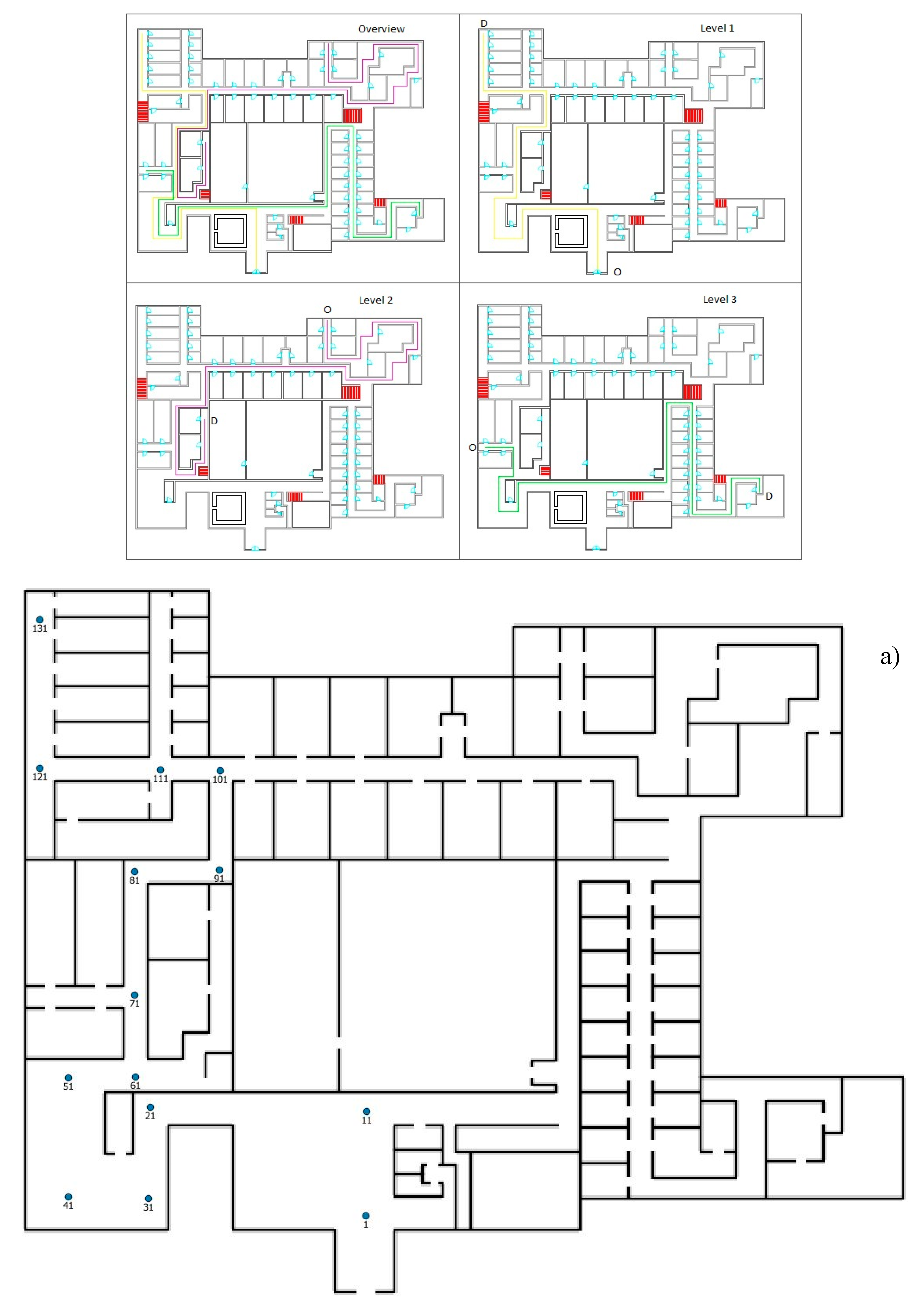

References
- Deterding, S.; Sicart, M.; Nacke, L.; O’Hara, K.; Dixon, D. Gamification using game-design elements in non-gaming contexts. In Proceedings of the CHI’11 Extended Abstracts on Human Factors in Computing Systems, Vancouver, BC, Canada, 7–12 May 2011; pp. 2425–2428. [Google Scholar] [CrossRef]
- Weisman, J. Evaluating architectural legibility: Way-finding in the built environment. Environ. Behav. 1981, 13, 189–204. [Google Scholar] [CrossRef]
- Passini, R. Wayfinding: A conceptual framework. Urban Ecol. 1981, 5, 17–31. [Google Scholar] [CrossRef]
- Farr, A.C.; Kleinschmidt, T.; Yarlagadda, P.; Mengersen, K. Wayfinding: A simple concept, a complex process. Transp. Rev. 2012, 32, 715–743. [Google Scholar] [CrossRef] [Green Version]
- Downs, R.M.; Stea, D. Image and Environment: Cognitive Mapping and Spatial Behavior; Transaction Publishers: Piscataway, NJ, USA, 1973. [Google Scholar]
- Viaene, P. Indoor Landmarks: The Study and Implementation of Wayfinding Aids; Ghent University Faculty of Sciences: Ghent, Belgium, 2018. [Google Scholar]
- Lorenz, B.; Ohlbach, H.J.; Stoffel, E.P. A hybrid spatial model for representing indoor environments. In Proceedings of the International Symposium on Web and Wireless Geographical Information Systems, Hong Kong, China, 4–5 December 2006; pp. 102–112. [Google Scholar]
- Bafna, S. Space syntax: A brief introduction to its logic and analytical techniques. Environ. Behav. 2003, 35, 17–29. [Google Scholar] [CrossRef]
- Li, R.; Klippel, A. Using space syntax to understand knowledge acquisition and wayfinding in indoor environments. In Proceedings of the 9th IEEE International Conference on Cognitive Informatics, Beijing, China, 7–9 July 2010; pp. 302–307. [Google Scholar] [CrossRef] [Green Version]
- Wiener, J.M.; Franz, G. Isovists as a means to predict spatial experience and behaviour. In Proceedings of the International Conference on Spatial Cognition, Frauenchiemsee, Germany, 11–13 October 2004; pp. 42–57. [Google Scholar] [CrossRef] [Green Version]
- Montello, D.R. Spatial cognition and architectural space: Research perspectives. Archit. Des. 2014, 84, 74–79. [Google Scholar] [CrossRef]
- De Cock, L.; Ooms, K.; Van de Weghe, N.; Vanhaeren, N.; Pauwels, P.; De Maeyer, P. Identifying what constitutes complexity perception of decision points during indoor route guidance. Int. J. Geogr. Inf. Sci. 2020, 1–19. [Google Scholar] [CrossRef]
- Vanhaeren, N.; De Cock, L.; Lapon, L.; Van de Weghe, N.; Ooms, K.; De Maeyer, P. On the Right Track: Comfort and Confusion in Indoor Environments. ISPRS Int. J. Geo-Inf. 2020, 9, 132. [Google Scholar] [CrossRef] [Green Version]
- De Cock, L.; Ooms, K.; Van de Weghe, N.; Vanhaeren, N.; De Maeyer, P. User Preferences on Route Instruction Types for Mobile Indoor Route Guidance. ISPRS Int. J. Geo-Inf. 2019, 8, 482. [Google Scholar] [CrossRef] [Green Version]
- Zichermann, G.; Cunningham, C. Gamification by Design: Implementing Game Mechanics in Web and Mobile Apps; O’Reilly Media, Inc.: Sebastopol, CA, USA, 2011. [Google Scholar]
- Kapp, K.M. The Gamification of Learning and Instruction: Game-Based Methods and Strategies for Training and Education; John Wiley & Sons: Hoboken, NJ, USA, 2012. [Google Scholar]
- Xu, F.; Buhalis, D.; Weber, J. Serious games and the gamification of tourism. Tour. Manag. 2017, 60, 244–256. [Google Scholar] [CrossRef]
- Hamari, J.; Koivisto, J.; Sarsa, H. Does gamification work? A literature review of empirical studies on gamification. In Proceedings of the 47th International Conference on System Sciences, Waikoloa, HI, USA, 6–9 January 2014; pp. 3025–3034. [Google Scholar] [CrossRef]
- Newman, G.; Wiggins, A.; Crall, A.; Graham, E.; Newman, S.; Crowston, K. The future of citizen science: Emerging technologies and shifting paradigms. Front. Ecol. Environ. 2012, 10, 298–304. [Google Scholar] [CrossRef] [Green Version]
- Bowser, A.; Hansen, D.; He, Y.; Boston, C.; Reid, M.; Gunnell, L.; Preece, J. Using gamification to inspire new citizen science volunteers. In Proceedings of the First International Conference on Gameful Design, Research, and Applications, New York, NY, USA, 2–4 October 2013; pp. 18–25. [Google Scholar] [CrossRef]
- Van der Kuil, M.N.; Visser-Meily, J.M.; Evers, A.W.; Van der Ham, I.J. A usability study of a serious game in cognitive rehabilitation: A compensatory navigation training in acquired brain injury patients. Front. Psychol. 2018, 9, 846. [Google Scholar] [CrossRef] [PubMed] [Green Version]
- Spiers, H.; Hornberger, M.; Bohbot, V.; Dalton, R.; Hölscher, C.; Manley, E.; Weiner, J. Sea Hero Quest; Glitchers: London, UK, 2016. [Google Scholar]
- Noulas, A.; Scellato, S.; Mascolo, C.; Pontil, M. An empirical study of geographic user activity patterns in foursquare. In Proceedings of the Fifth International AAAI Conference on Weblogs and Social Media, Barcelona, Spain, 17–21 July 2011. [Google Scholar]
- McKenzie, G. Gamification and location-based services. In Proceedings of the Workshop on Cognitive Engineering for Mobile GIS, Belfast, ME, USA, 12 September 2011. [Google Scholar]
- Schwering, A.; Münzer, S.; Bartoschek, T.; Li, R. Gamification for spatial literacy: The use of a desktop application to foster map-based competencies. In Proceedings of the 17th AGILE International Conference on Geographic Information Science-Workshop Games, Castellón, Spain, 3–6 June 2014. [Google Scholar]
- Bartoschek, T.; Schwering, A.; Li, R.; Münzer, S.; Carlos, V. OriGami: A mobile geogame for spatial literacy. In Geogames and Geoplay; Springer: Cham, Switzerland, 2018; pp. 37–62. [Google Scholar]
- Schlieder, C.; Kiefer, P.; Matyas, S. Geogames: Designing location-based games from classic board games. IEEE Intell. Syst. 2006, 21, 40–46. [Google Scholar] [CrossRef]
- Schlieder, C. Representing the meaning of spatial behavior by spatially grounded intentional systems. In Proceedings of the International Conference on GeoSpatial Sematics, Mexico City, Mexico, 29–30 November 2005. [Google Scholar]
- Feulner, B.; Kremer, D. Using geogames to foster spatial thinking. In Proceedings of the GI_Forum—Geospatial Innovation for Society, Salzburg, Germany, 6–10 July 2014. [Google Scholar]
- Bell, M.; Chalmers, M.; Barkhuus, L.; Hall, M.; Sherwood, S.; Tennent, P.; Hampshire, A. Interweaving mobile games with everyday life. In Proceedings of the SIGCHI Conference on Human Factors in Computing Systems, New York, NY, USA, 5–10 April 2006; pp. 417–426. [Google Scholar]
- Chakraborty, N.; Haworth, B.; Usman, M.; Berseth, G.; Faloutsos, P.; Kapadia, M. Crowd sourced co-design of floor plans using simulation guided games. In Proceedings of the Tenth International Conference on Motion in Games, Barcelona, Spain, 8–10 November 2017; pp. 1–5. [Google Scholar]
- Usman, M.; Schaumann, D.; Haworth, B.; Berseth, G.; Kapadia, M.; Faloutsos, P. Interactive spatial analytics for human-aware building design. In Proceedings of the 11th Annual International Conference on Motion, Interaction, and Games, Limassol, Cyprus, 8–10 November 2018; pp. 1–12. [Google Scholar]
- Yesiltepe, D.; Dalton, R.; Ozbil, A.; Dalton, N.; Noble, S.; Hornberger, M.; Spiers, H. Usage of Landmarks in Virtual Environments for Wayfinding: Research on the influence of global landmarks. In Proceedings of the 12th International Space Syntax Symposium, Beijing, China, 8–13 July 2019. [Google Scholar]
- Ramadan, R.; Widyani, Y. Game development life cycle guidelines. In Proceedings of the International Conference on Advanced Computer Science and Information Systems, Kuta, Indonesia, 28–29 September 2013; pp. 95–100. [Google Scholar] [CrossRef]
- McElhinney, S. Isovist_2.1: A Basic User Guide, v1.1. Available online: http://www. isovists.org/user_guide/ (accessed on 3 March 2020).
- Powers, K.L.; Brooks, P.J.; Aldrich, N.J.; Palladino, M.A.; Alfieri, L. Effects of video-game play on information processing: A meta-analytic investigation. Psychon. Bull. Rev. 2013, 20, 1055–1079. [Google Scholar] [CrossRef] [PubMed] [Green Version]
- Groeppel-Klein, A.; Bartmann, B. Anti-clockwise or clockwise? The impact of store layout on the process of orientation in a discount store. Eur. Adv. Consum. Res. 2007, 8, 415–416. [Google Scholar]
- Dogu, U.; Erkip, F. Spatial factors affecting wayfinding and orientation: A case study in a shopping mall. Environ. Behav. 2000, 32, 731–755. [Google Scholar] [CrossRef]
- Baskaya, A. Wayfinding in an unfamiliar environment: Different spatial settings of two polyclinics. Environ. Behav. 2004, 36, 839–867. [Google Scholar] [CrossRef] [Green Version]
- Marquardt, G.; Schmieg, P. Dementia-friendly architecture: Environments that facilitate wayfinding in nursing homes. Am. J. Alzheimer’s Dis. Other Dement. 2009, 24, 333–340. [Google Scholar] [CrossRef] [PubMed] [Green Version]
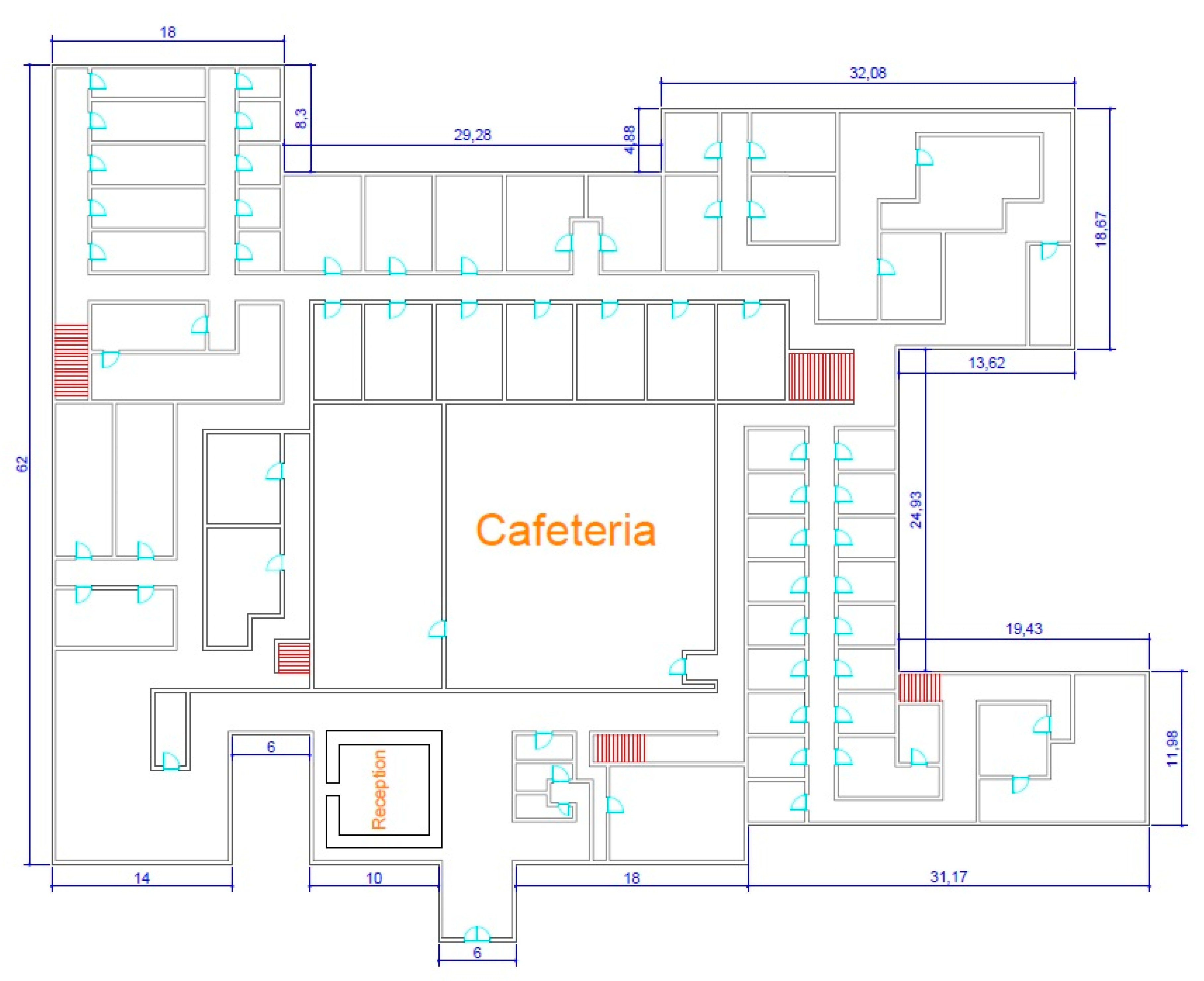
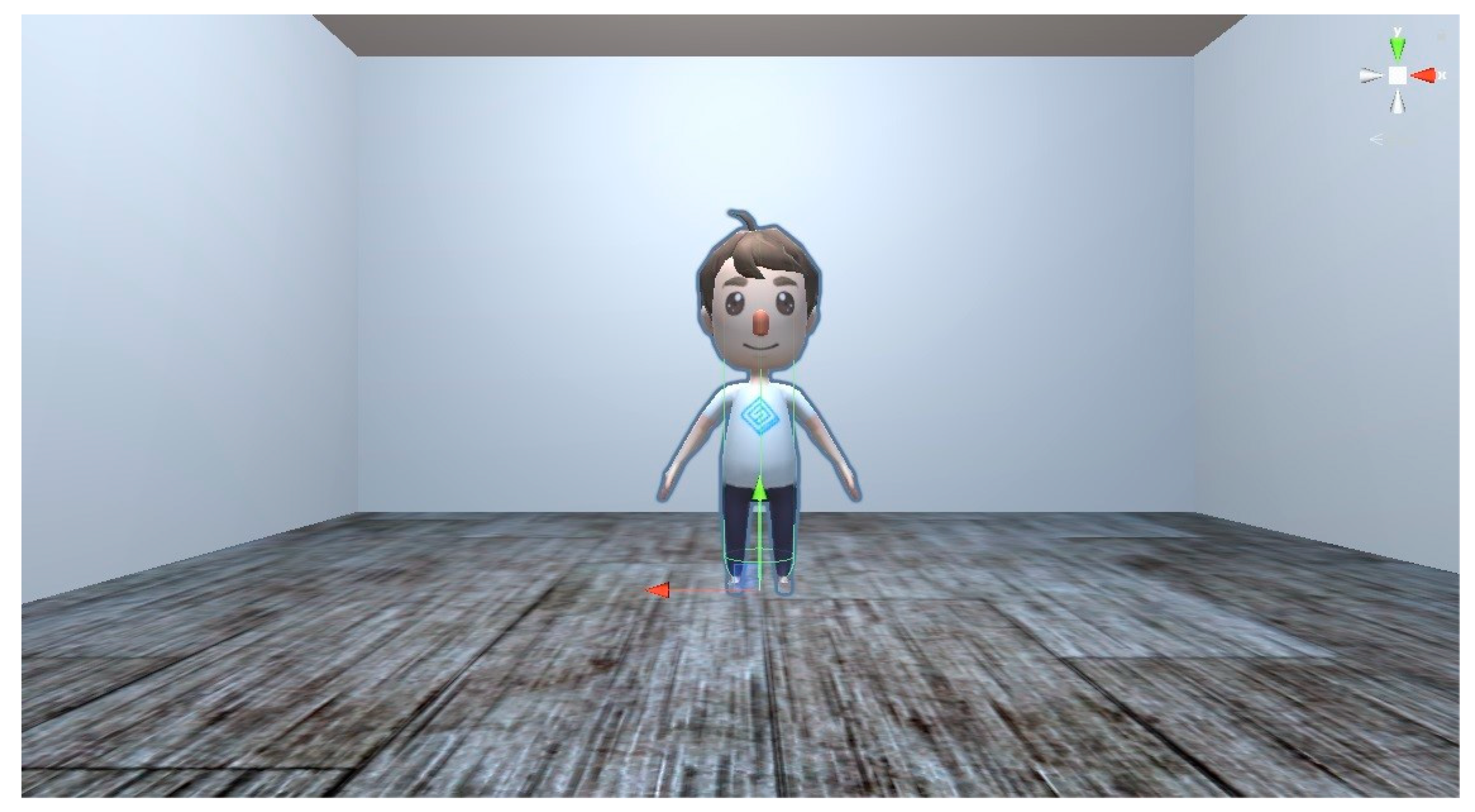
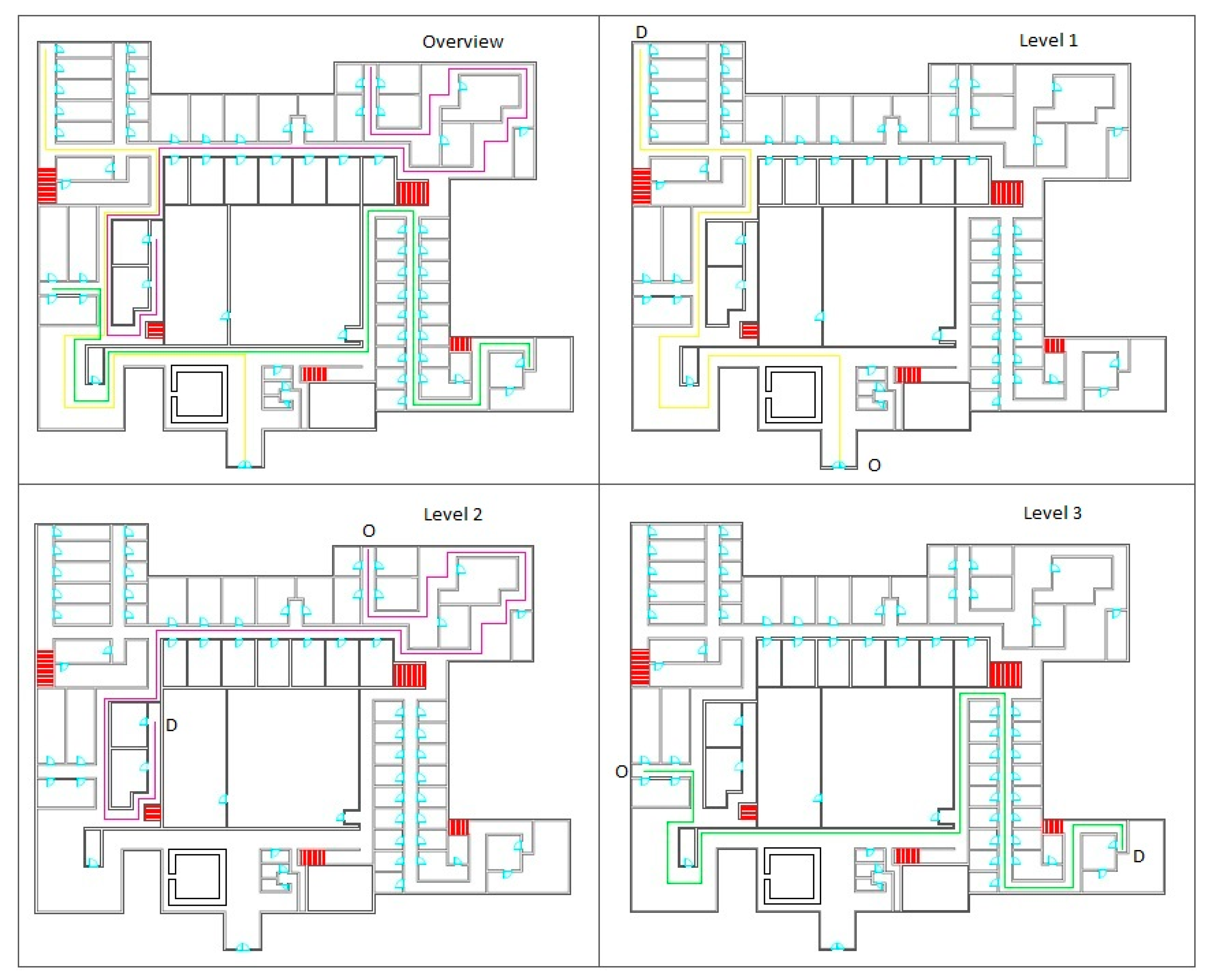
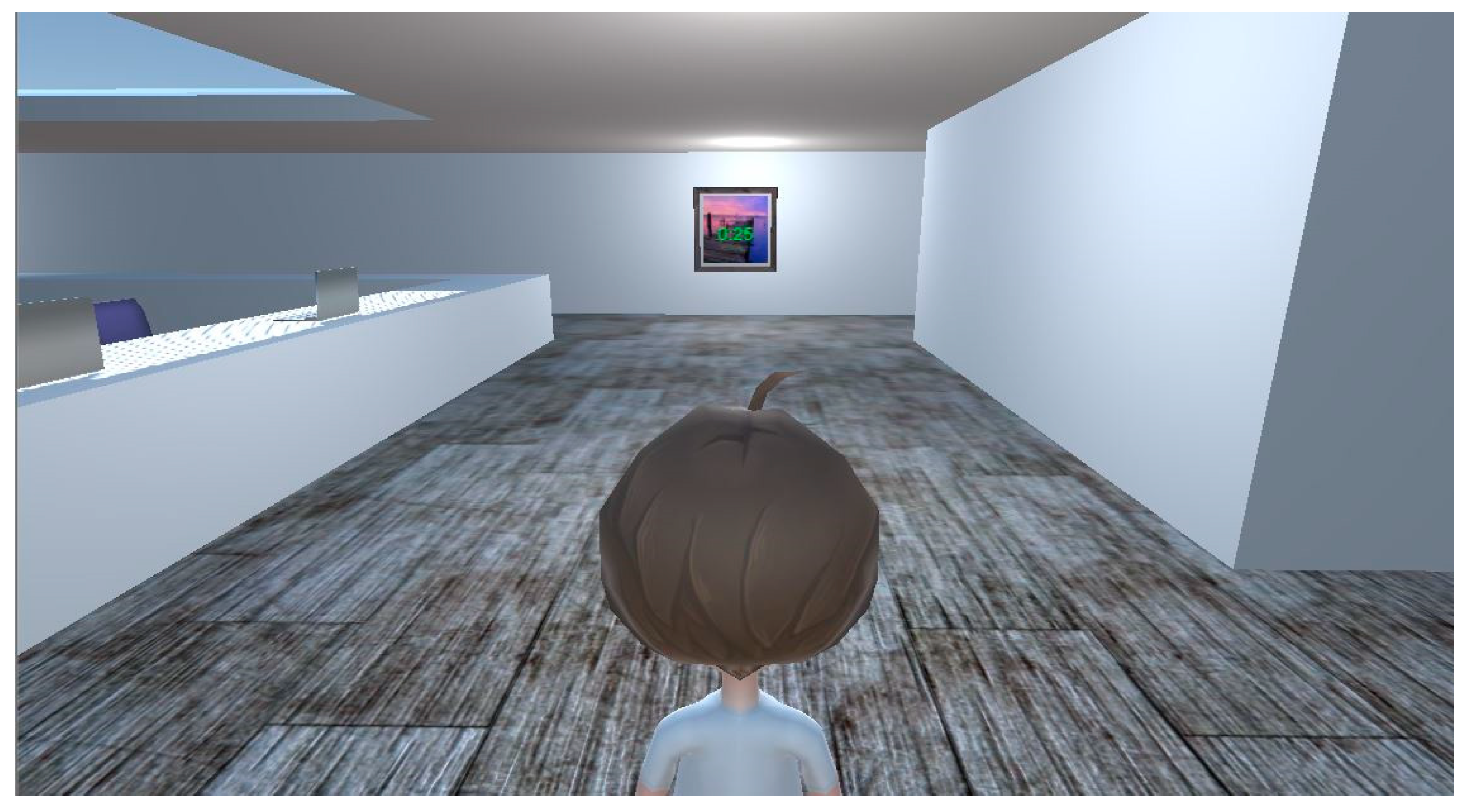
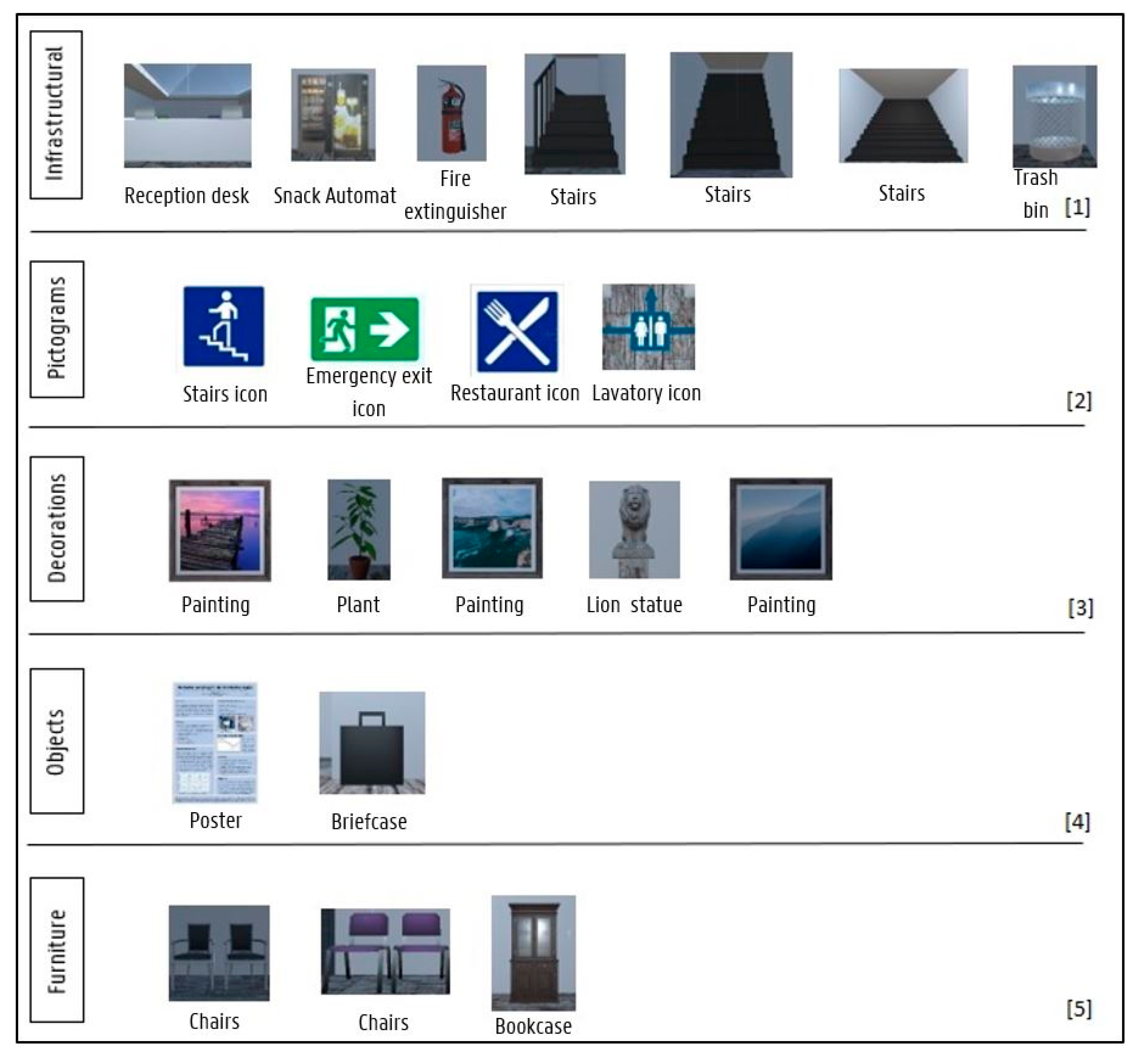
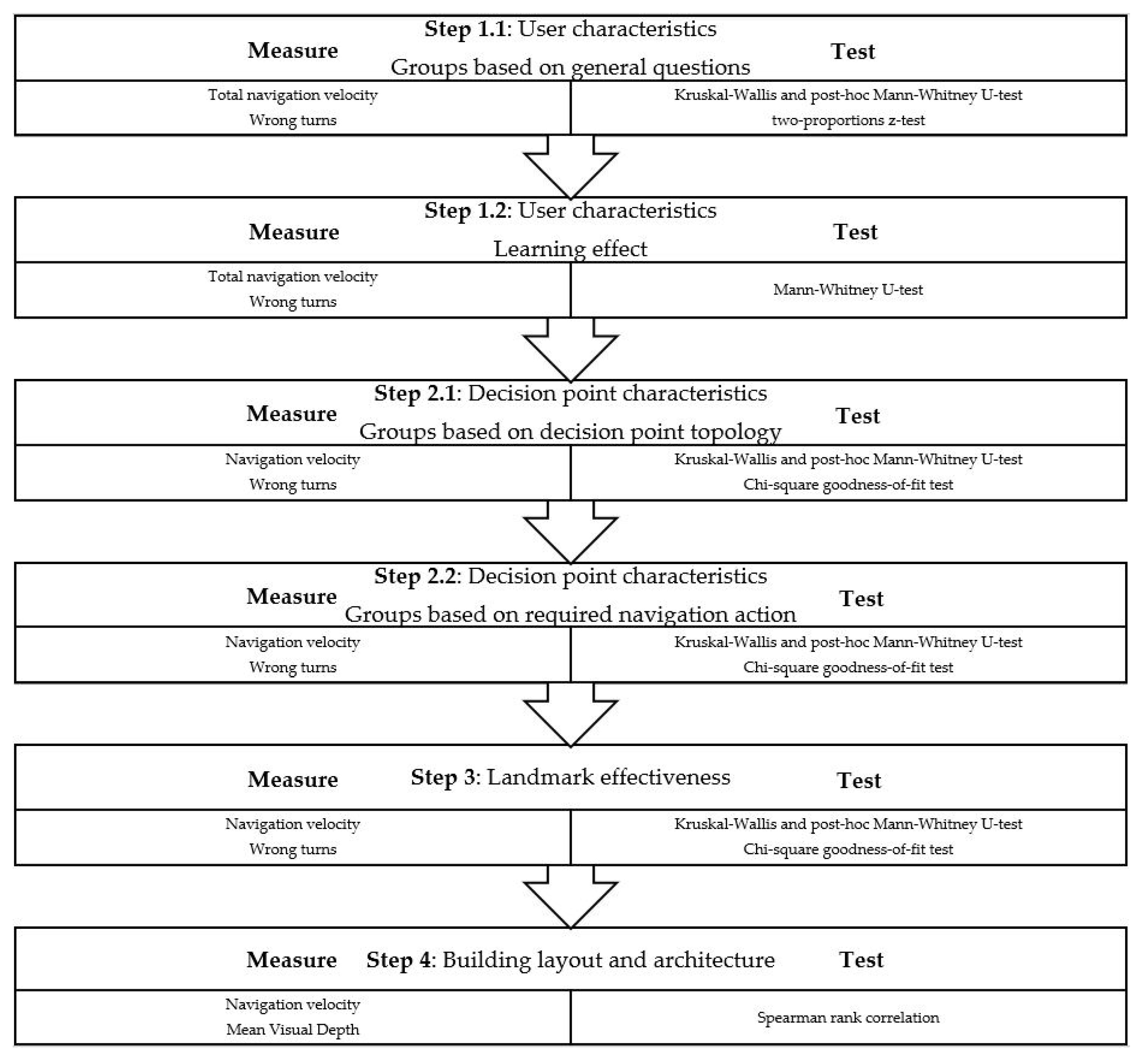
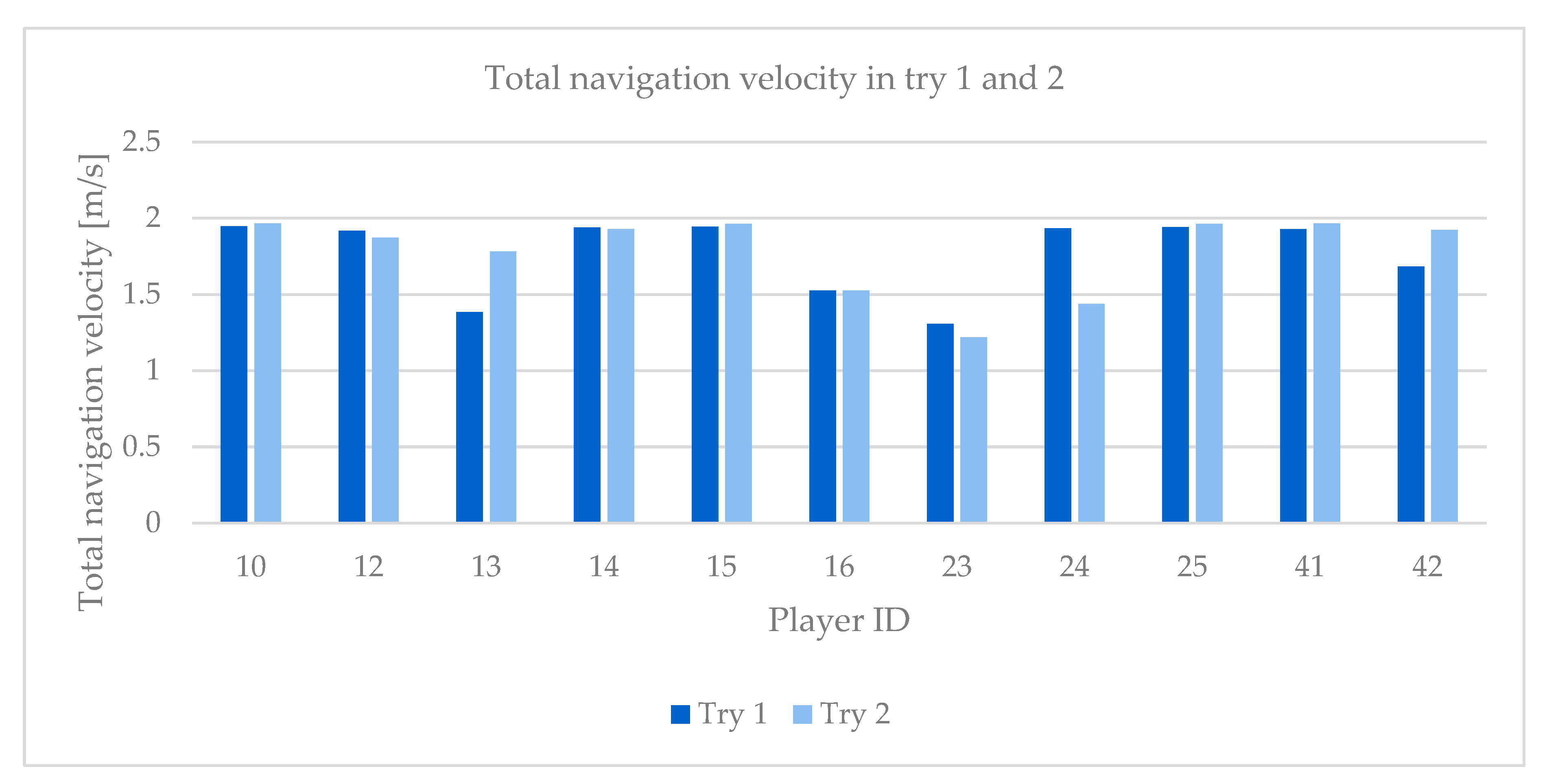
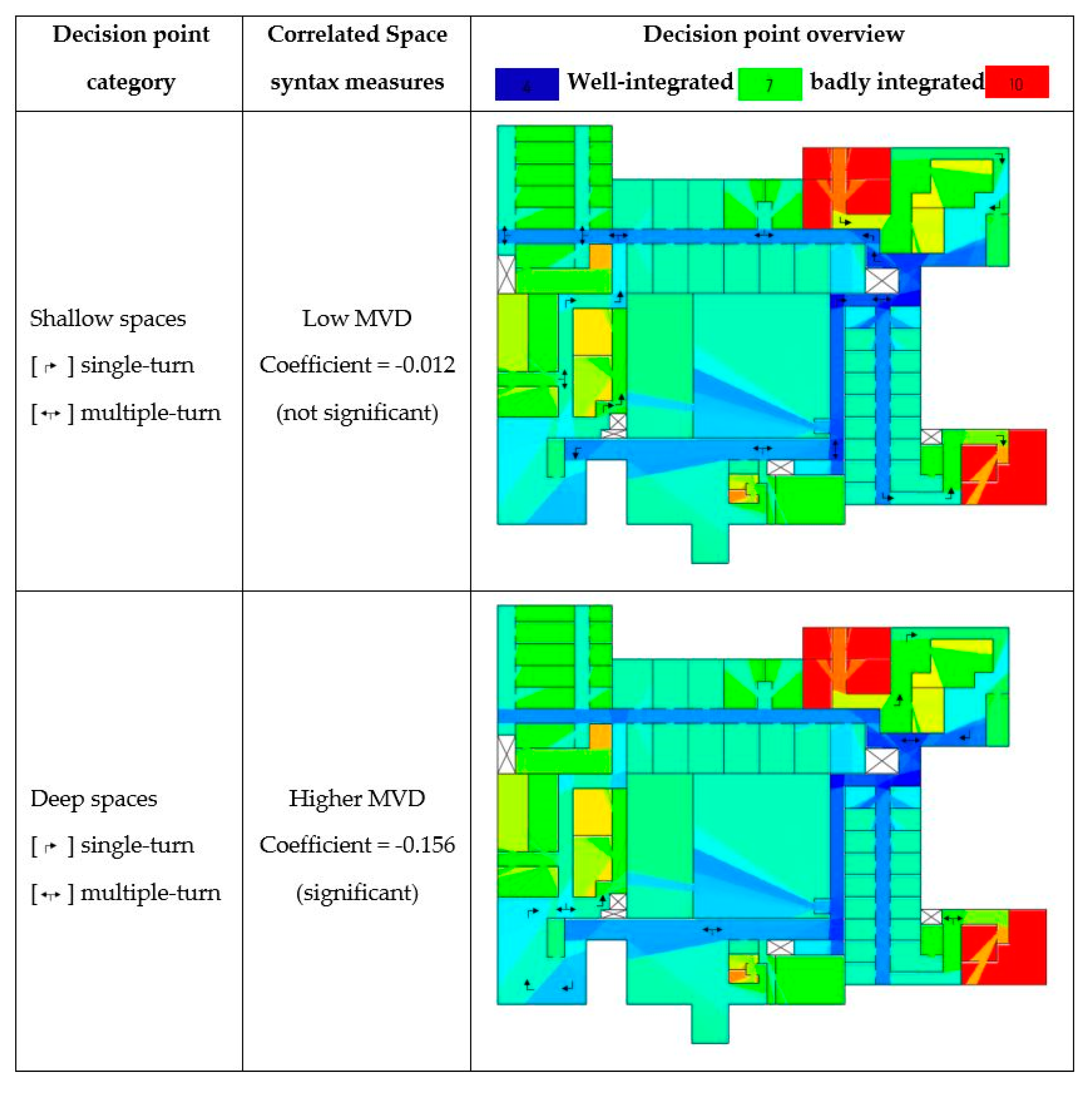

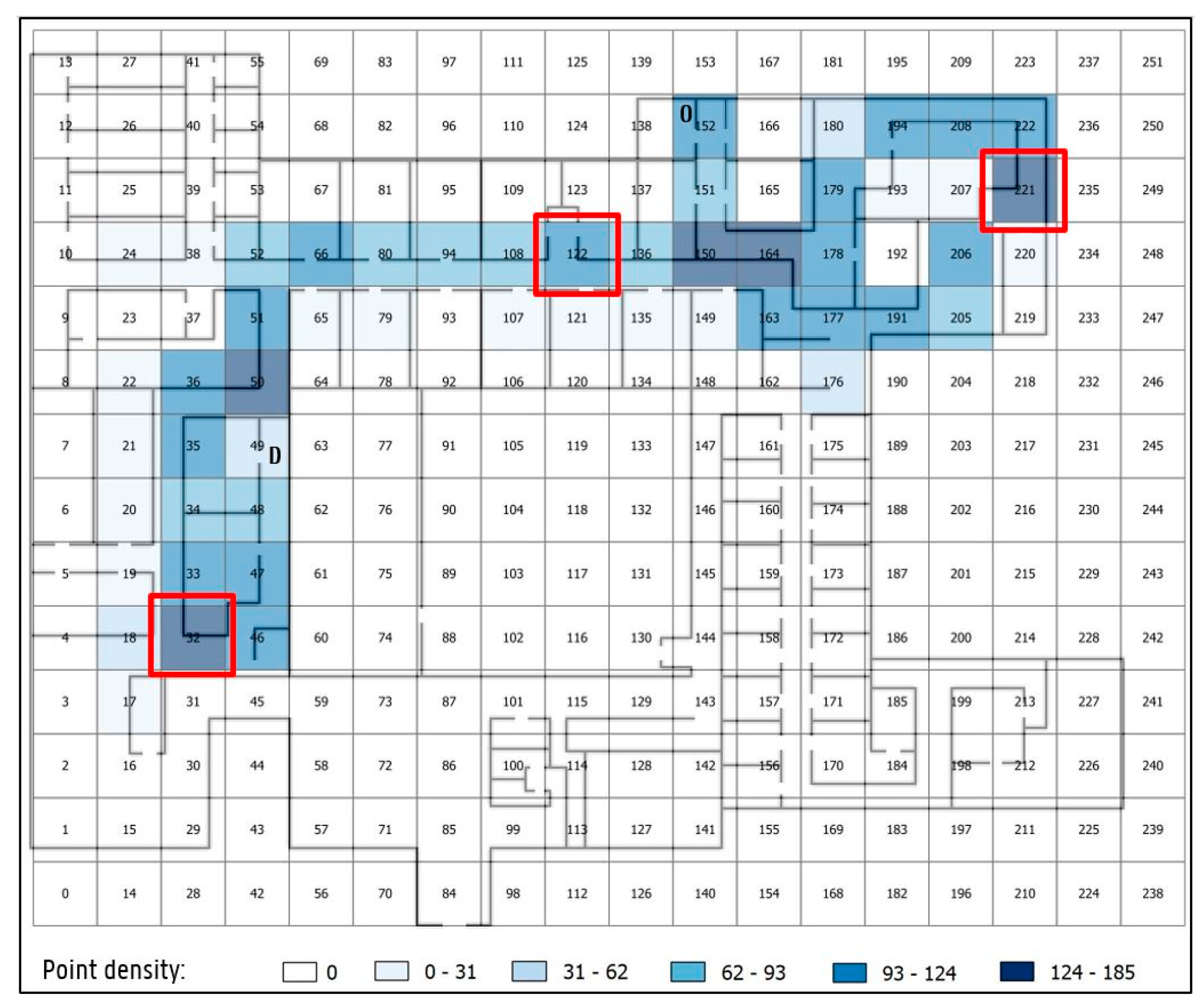
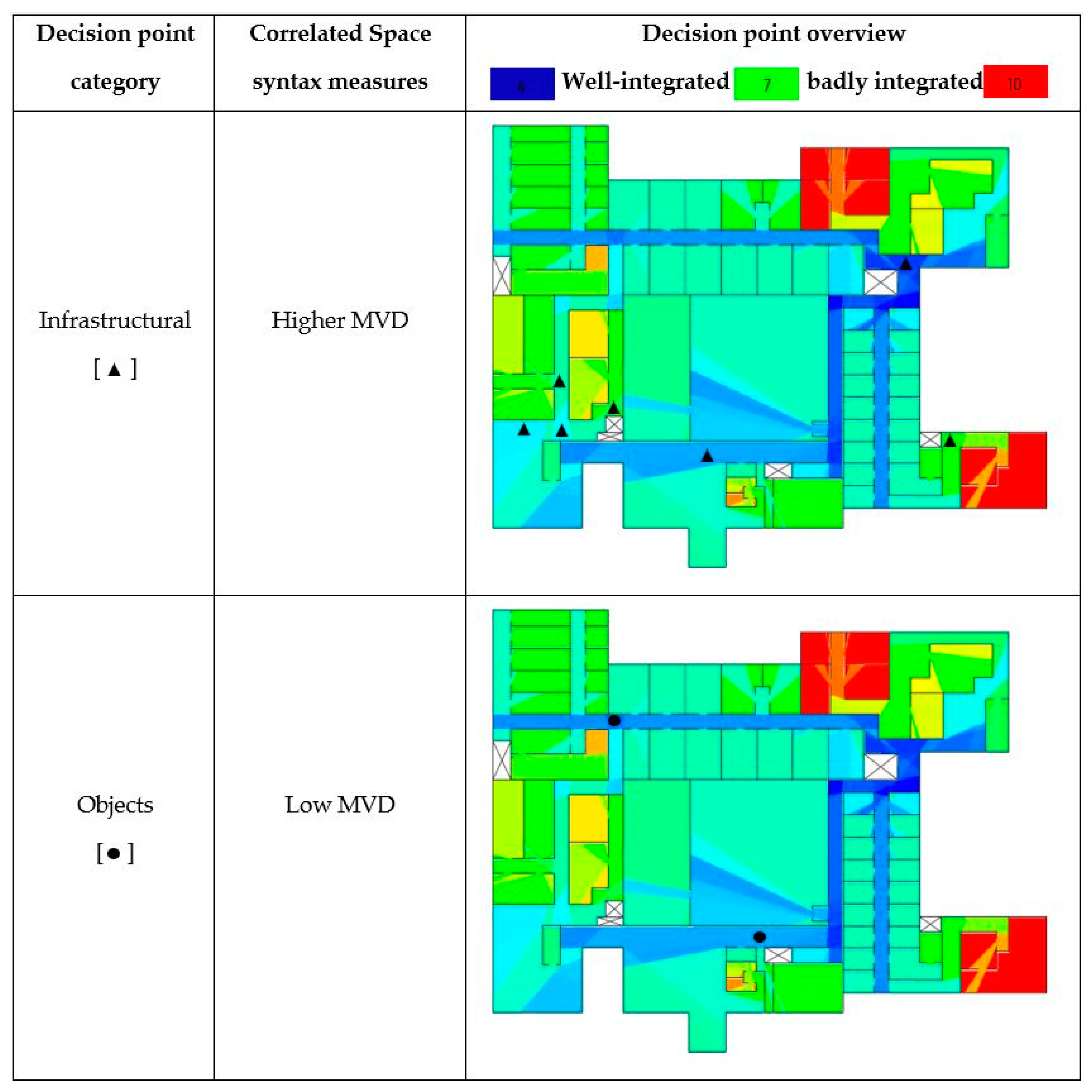
| Number | ID | Landmark | DP | Level | Unique ID |
|---|---|---|---|---|---|
| 1 | 1 | Reception Desk | 0 | 1 | 1 |
| 2 | 2 | Painting 1 | 1 | 1 | 11 |
| 3 | 3 | Plant | 3 | 1 | 31 |
| 4 | 4 | Chairs | 4 | 1 | 41 |
| 5 | 5 | Snack Automat | 5 | 1 | 51 |
| 6 | 6 | Stairs | 6 | 1 | 61 |
| 7 | 7 | Fire Extinguisher | 7 | 1 | 71 |
| 8 | 8 | Poster | 10 | 1 | 101 |
| 9 | 9 | Stairs Icon | 12 | 1 | 121 |
| 10 | 10 | Waiting Chairs | 1 | 2 | 12 |
| 11 | 3 | Plant | 3 | 2 | 32 |
| 12 | 11 | Emergency Exit Icon | 4 | 2 | 42 |
| 13 | 12 | Painting 2 | 5 | 2 | 52 |
| 14 | 13 | Stairs | 6 | 2 | 62 |
| 15 | 14 | Lavatory Icon | 9 | 2 | 92 |
| 16 | 8 | Poster | 10 | 2 | 102 |
| 17 | 7 | Fire Extinguisher | 13 | 2 | 132 |
| 18 | 9 | Stairs Icon | 14 | 2 | 142 |
| 19 | 6 | Stairs | 15 | 2 | 152 |
| 21 | 7 | Fire Extinguisher | 0 | 3 | 3 |
| 22 | 9 | Stairs Icon | 1 | 3 | 13 |
| 23 | 5 | Snack Automat | 2 | 3 | 23 |
| 24 | 4 | Chairs | 3 | 3 | 33 |
| 25 | 3 | Plant | 4 | 3 | 43 |
| 26 | 2 | Painting 1 | 6 | 3 | 63 |
| 27 | 16 | Briefcase | 7 | 3 | 73 |
| 28 | 17 | Bookcase | 8 | 3 | 83 |
| 29 | 18 | Restaurant Icon | 9 | 3 | 93 |
| 30 | 19 | Lion Statue | 11 | 3 | 113 |
| 31 | 20 | Painting 3 | 13 | 3 | 133 |
| 32 | 21 | Stairs | 14 | 3 | 143 |
| Age Category | Education Level | At least One Wrong Turn | |||
|---|---|---|---|---|---|
| 18–20 | 27% | Higher | 98% | Yes | 83% |
| 21–25 | 56% | Primary | 2% | No | 17% |
| 26–30 | 10% | ||||
| 30+ | 7% | ||||
| General questions | |||||
| Do you often have trouble with indoor wayfinding? | Do you often play video games? | ||||
| Yes | 24% | 32% | |||
| No | 76% | 68% | |||
| Groups of Participants | p Values |
|---|---|
| One-tailed significance values resulting from a Kruskal–Wallis test | |
| Question (1) Do you often have trouble with indoor wayfinding? | 0.832 |
| At least one wrong turn | 0.332 |
| Question (2) Do you often play video games? | 0.000 * |
| One-tailed significance value resulting from a Mann–Whitney U-test (with Bonferroni correction) | |
| Question (2) Yes > No | 0.000 * |
| Groups of Participants | p Values |
|---|---|
| * Two-proportions z-test | |
| Question (1) Do you often have trouble with indoor wayfinding? | 0.465 |
| Question (2) Do you often play video games? | 0.804 |
| Player ID | Try 1 | Try 2 |
|---|---|---|
| 10 | 2 | 0 |
| 12 | 0 | 0 |
| 13 | 3 | 0 |
| 14 | 0 | 2 |
| 15 | 1 | 0 |
| 16 | 0 | 2 |
| 23 | 0 | 3 |
| 24 | 0 | 1 |
| 25 | 1 | 2 |
| 41 | 0 | 0 |
| 42 | 1 | 0 |
| Groups of Decision Points | p Values |
|---|---|
| One-tailed significance values resulting from a Kruskal–Wallis test | |
| Categorization based on the topology | 0.000 * |
| Categorization based on the required wayfinding action | 0.000 * |
| One-tailed significance values resulting from a Mann–Whitney U-test (with Bonferroni correction) | |
| Topology-based | |
| Single-turn > Multiple-turn | 0.999 |
| Single-turn > Start/end | 0.000 * |
| Multiple-turn > Single-turn | 0.000 * |
| Multiple-turn > Start/end | 0.000 * |
| Start/end > Single-turn | 0.999 |
| Start/end > Multiple-turn | 0.999 |
| Wayfinding action-based | |
| Straightforward > Turn right | 0.000 * |
| Straightforward > Turn left | 0.000 * |
| Turn right > Turn left | 0.999 |
| Turn right > Straight forward | 0.999 |
| Turn left > Turn right | 0.999 |
| Turn left > Straight forward | 0.999 |
| Group | Observed | Expected | |
| Straightforward | 13 | 29.7 | |
| Turn left | 38 | 19.8 | |
| Turn right | 15 | 16.5 | |
| Chi-square | 0.000 * | ||
| Groups of Landmarks | p Values |
|---|---|
| One-tailed significance value resulting from a Kruskal–Wallis test | |
| Categorization | 0.000 * |
| One-tailed significance values resulting from a Mann–Whitney U-test (with Bonferroni correction) | |
| No landmark > Furniture | 0.008 * |
| Infrastructural > Furniture | 0.018 * |
| Objects > No landmark | 0.000 * |
| Objects > Infrastructural | 0.000 * |
| Objects > Pictograms | 0.000 * |
| Objects > Decorations | 0.000 * |
| Objects > Furniture | 0.000 * |
| Group | Observed | Expected | |
|---|---|---|---|
| Infrastructural | 20 | 27.79 | |
| Pictograms | 11 | 17.36 | |
| Decorations | 11 | 6.95 | |
| Objects | 13 | 10.42 | |
| Furniture | 11 | 3.47 | |
| Chi-square | 0.000 * | ||
| Groups | Correlation Coefficient |
|---|---|
| Spearman rank correlation | |
| General coefficient | −0.063 * |
| Deep spaces | −0.156 * |
| Shallow spaces | −0.012 |
| Decision Point (Unique ID) | Wrong Turns | Landmark Type-Based Category | Topology-Based Category |
|---|---|---|---|
| 3 | 4 | Infrastructural | Turn right |
| 11 | 4 | Decorations | Turn left |
| 13 | 4 | Pictograms | Turn right |
| 61 | 4 | Infrastructural | Turn left |
| 62 | 8 | Infrastructural | Straight forward |
| 71 | 3 | Infrastructural | Straight forward |
| 83 | 11 | Furniture | Turn left |
| 92 | 1 | Pictograms | Straight forward |
| 101 | 7 | Objects | Turn left |
| 102 | 6 | Objects | Turn left |
| 113 | 7 | Decorations | Turn right |
| 132 | 1 | Infrastructural | Straight forward |
| 142 | 6 | Pictograms | Turn left |
| Landmark Category | Decision Points that Require a Turn (%) | Observed Wrong Turns | Expected Wrong Turns |
|---|---|---|---|
| No landmark | 78% | - | - |
| Infrastructural | 58% | 20 | 27.79 |
| Pictograms | 67% | 11 | 17.36 |
| Decorations | 100% | 11 | 6.95 |
| Objects | 67% | 13 | 10.42 |
| Furniture | 100% | 11 | 3.47 |
| Landmark Category | Mean MVD Value | Mean Navigation Velocity (m/s) |
|---|---|---|
| Infrastructural | 6.19 | 1.79 |
| Objects | 5.37 | 1.85 |
| Infrastructural Decision Point (ID) | MVD value | navigation velocity (m/s) |
| 61 | 6.01 | 1.96 |
| 152 | 6.44 | 1.82 |
| 172 | 6.93 | 1.58 |
| 143 | 7.23 | 1.11 |
© 2020 by the authors. Licensee MDPI, Basel, Switzerland. This article is an open access article distributed under the terms and conditions of the Creative Commons Attribution (CC BY) license (http://creativecommons.org/licenses/by/4.0/).
Share and Cite
De Leeuw, D.; De Maeyer, P.; De Cock, L. A Gamification-Based Approach on Indoor Wayfinding Research. ISPRS Int. J. Geo-Inf. 2020, 9, 423. https://doi.org/10.3390/ijgi9070423
De Leeuw D, De Maeyer P, De Cock L. A Gamification-Based Approach on Indoor Wayfinding Research. ISPRS International Journal of Geo-Information. 2020; 9(7):423. https://doi.org/10.3390/ijgi9070423
Chicago/Turabian StyleDe Leeuw, Dries, Philippe De Maeyer, and Laure De Cock. 2020. "A Gamification-Based Approach on Indoor Wayfinding Research" ISPRS International Journal of Geo-Information 9, no. 7: 423. https://doi.org/10.3390/ijgi9070423







